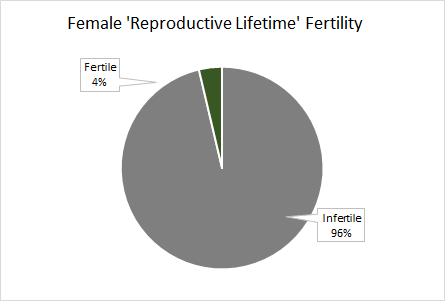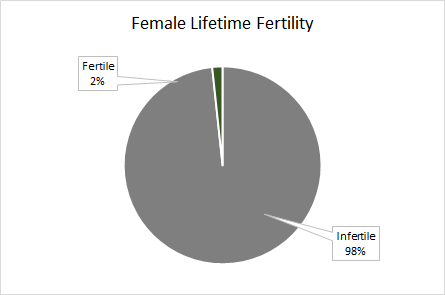"NO MORE CHRISTIAN DOCTORS"
Appendix "E"
Human Fertility Cycles
Full Text

Introduction
What is provided here is not exhaustive. It is intended only to
provide the reader with sufficient information to understand the factors
and issues likely to be involved when health care workers decline to
provide contraception services for reasons of conscience.
E1. Male fertility
Sperm production begins during puberty, generally between the ages of 10
and 15. For present purposes an approximate age of 14 is a
satisfactory estimate.1 From that point until death, sperm production
is continuous.
Sperm that is not ejaculated is reabsorbed by the body.2 Outside
the body, the lifespan of sperm depends upon the environment. In a
hostile environment, sperm will die rapidly, though it may live a few hours
in seminal fluid.3
In a supportive environment, sperm can live five to seven days, though five
days seems to be the commonly accepted upper limit.4
Since sperm production is continuous from puberty until death, fertility
during a man's reproductive lifespan can be represented by a pie chart
illustrating fertility for 100% of that period (Chart E1.1). Male
fertility can also be represented by a pie chart illustrating fertility as a
percentage of the average male lifespan (Chart E1.2).
A woman actually begins the production of oocytes during her development
as a foetus. By puberty she has about 400,000 primary oocytes in her
ovaries. The popular term for an oocyte (primary or secondary) is
"egg," so that term is used here.5 Ovulation - release of the egg from
the ovary- occurs during each menstrual cycle. The age at which the
first and last menstrual cycles occurs is quite variable. For present
purposes we assume they begin at about age 12,
and end at about age 50.
After ovulation an egg must be fertilized within 12 to 24 hours, or
fertilization cannot take place and it will die. Thus, for
reproductive purposes, the lifespan of an egg can be said to be 12 to 24
hours.6
From the beginning of sperm production at puberty until death, a
man has the capacity to cause a pregnancy 24 hours a day, 365 days a year.
In contrast, a woman can become pregnant only for a 12 to 24 hour period
following ovulation during each menstrual cycle. The enormous
difference between the male and female fertility pattern becomes more
readily apparent when the female pattern is illustrated by a pie chart.
Calculations to produce the chart begin by calculating an approximate
reproductive lifespan, assuming that ovulation begins at about age 12, and ends at about age 50.
50-12 = 38 years
Assume 13 cycles per year.
38 X 13 = 494 cycles in a lifetime.
IN EACH CYCLE
Assume egg present one day
494 cycles X 1 = 494 days
Expressed as years
494 days / 365 days = about 1.4 years.
Expressed as a percentage of average
reproductive lifespan (38 years)
= about 4% (Chart E2.1)
Expressed as a percentage of women's average
lifespan (83 years)
= about 2% (Chart E2.2)
Chart E.2.1 (click
to enlarge)

Chart E2.2 (click
to enlarge)

E3. Combined fertility
While fertilization can occur during only a 12-24 hour time-span during each
menstrual cycle, or about 4% of a woman's reproductive lifespan, this does
not mean that she can become pregnant only if sexual intercourse occurs
while the egg is available for fertilization.
The reason for this is that the lifespan of sperm in the female
reproductive tract increases dramatically in the presence of a specific kind
of cervical mucus produced in the days leading up to ovulation. This
mucus will sustain viable sperm for three to five or even seven days.4 It is, in
fact, essential if fertilization is to occur. In the presence of this
sperm-supportive mucus, sexual intercourse on a Wednesday (before ovulation)
can result in a pregnancy after ovulation on Saturday.
We can illustrate the combined fertility pattern using a pie chart.
We begin the calculations as we did above, assuming a 38 year reproductive
lifespan with 13 reproductive cycles per year, yielding 494 cycles in a
lifetime.
IN EACH CYCLE
Assume seven days combined fertility
494 cycles X 7= 3,458 days
Expressed as years
3,458 days / 365 days = about 9.5 years
Expressed as percentage
= about 25% (Chart E3.1
E4. Comparing Male, Female and Combined Fertility Patterns
1. Kuhn HE, Frontera MA, Demers LM,
Bartholomew MJ, Lloyd TA. The Onset of Sperm
Production in Pubertal Boys: Relationship
to Gonadotropin Excretion. Am J Dis
Child. 1989;143(2):190-193. doi:10.1001/archpedi.1989.02150140080024
2. WEBMD, Birth Control Health Center:
Vasectomy. (Accessed 2014-02-13)
3. Harms RW,
Sperm: How long do they live after ejaculation? Mayo
Clinic, 5 May, 2012 (Accessed 2014-02-14)
4. "[Our] finding. . . indicates that sperm retain their
ability to fertilize an ovum for up to five days in the female reproductive
tract . . . Motile sperm have been found in the cervical mucus for seven or
more days after insemination . . .". . Wilcox, A.J Clarice R. et al, "Timing
of Sexual Intercourse in Relation to Ovulation." N Eng J Med 1995; Vol. 333
No. 23: 1320, citing Perloff WH, Steinberger E., In vivo survival of
spermatozoa in cervical mucus. Am J Obstet Gynecol 1964; 88:439-42; and
Glezerman, M. Artificial Insemination. In Insler, V. Lunenfeld, B. eds.
Infertility: male and female. 2nd ed. New York: Churchill Livingstone, 1993.
5. O'Rahilly R. and Muller F. Human
Embryology & Teratology. New York: Wiley-Liss, 2001, p. 87. Quoted in
Irving D. "When do Human Beings Begin?
'Scientific' Myths and Scientific Facts." International Journal of Sociology and Social Policy 1999,
19:3/4:22-47
6. University of California San Francisco, Center for Reproductive
Health.
Conception: How it Works. (Accessed 2014-02-13